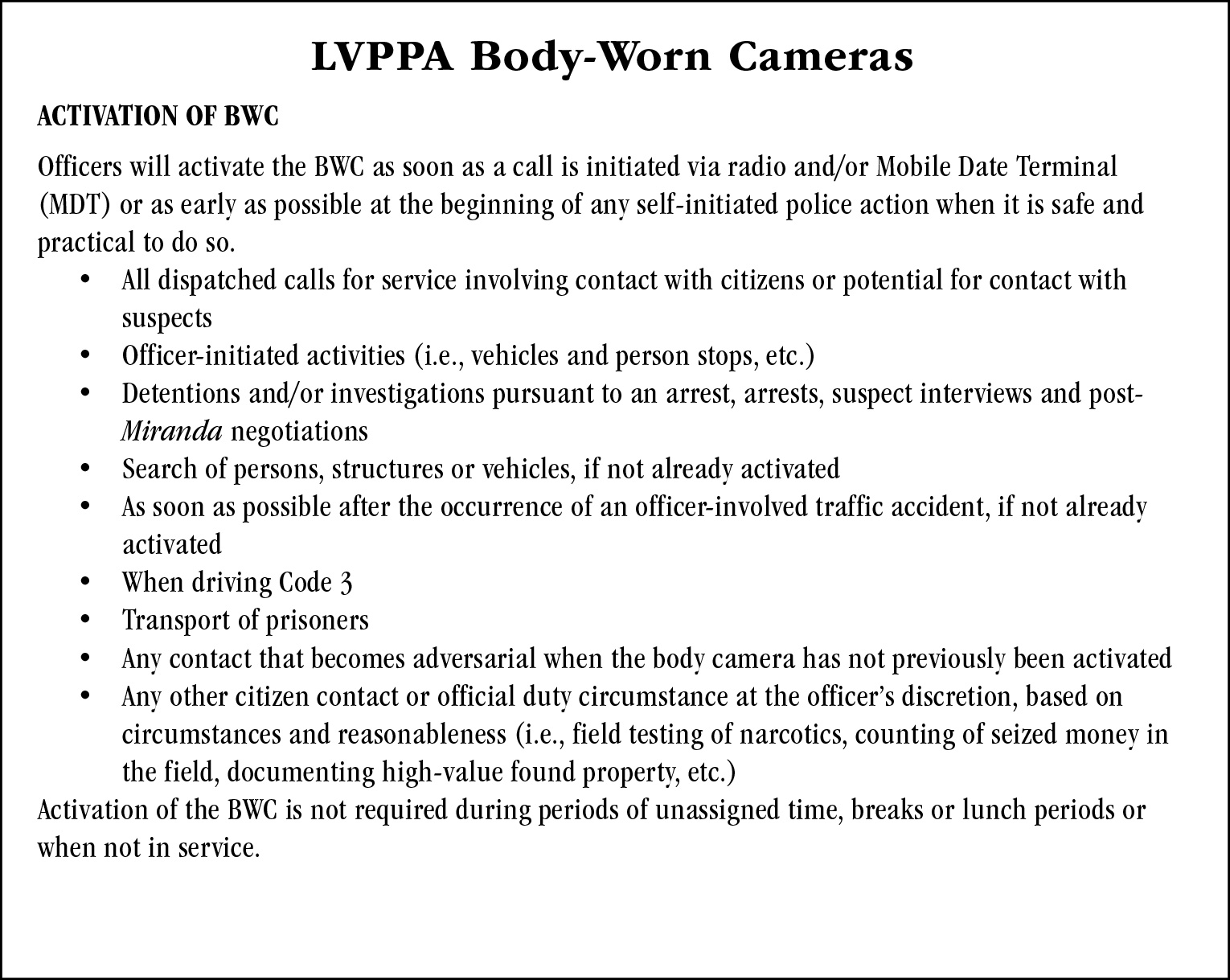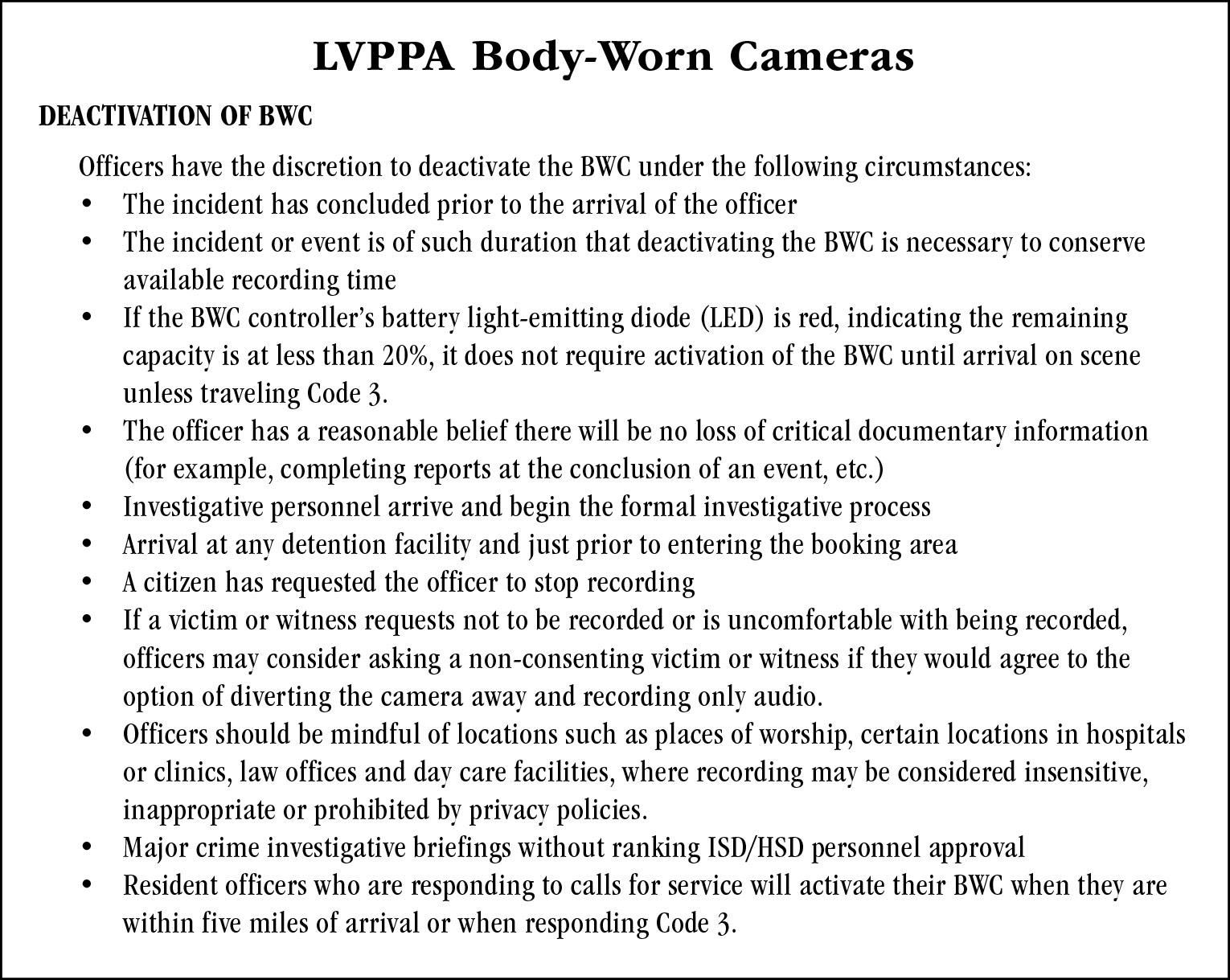
Sergeant-at-Arms
In recent years, body-worn cameras have become an essential tool in modern policing. The cameras mounted on officers’ uniforms provide real-time video and audio recordings of interactions between police officers and the public. Now, the new Axon cameras issued by LVMPD have two cameras that have the capability to record the event. While the use of body cameras has been widely debated, there is growing consensus about their importance in promoting transparency, accountability and trust between law enforcement and the communities they serve. However, to achieve these benefits, it is critical that body cameras are consistently activated during interactions with the public. LVMPD policy is clearly defined as to when officers should activate their cameras and when officers may deactivate them.
The primary purpose of police body cameras is to provide an objective record of events. When officers activate their body-worn cameras during interactions, it ensures that there is a clear, unbiased record of what transpired, protecting both the officers and the citizens involved. These recordings can be crucial in situations where there is conflicting testimony or allegations of misconduct. Without activated cameras, there is a lack of evidence that could help investigators defend the officer’s actions, which could lead to potential mistrust and allegations of bias or corruption.
Body-worn cameras play a critical role in holding both law enforcement officers and the public accountable. Critics believe that when officers know that their actions are being recorded, they are more likely to adhere to established protocols and exercise greater caution and professionalism. The presence of a camera can deter misconduct, including the use of excessive force, discriminatory behavior and even false claims of police misconduct by citizens. However, time and time again, even at the early stages of the implementation of the body-worn camera project, our officers have shown that we have met this standard with or without body-worn cameras.
Conversely, when citizens know that interactions are being recorded, they are also less likely to engage in disruptive or aggressive behavior. However, the body-worn cameras are a perfect tool to document and record the interaction and non-compliance of the citizens should the mere officer’s presence and body-worn camera not deter their actions. This mutual accountability helps create a safer environment for both police officers and civilians. Critics say it ensures that individuals are more likely to respect the law, knowing that their actions are being captured on video.
Body-worn cameras can also serve as valuable tools in criminal investigations and legal proceedings. For instance, when a suspect claims that they were treated unfairly or unlawfully by law enforcement, body-camera footage can help clarify the events that led to an arrest or use of force. This evidence can be used in court to corroborate or challenge testimonies, improving the quality of the criminal case with unbiased documentation of the scene, evidence, any statements made and injuries to victims, which strengthens the judicial process.
Despite the clear benefits of activating body-worn cameras, there are challenges and limitations that must be addressed. The body-worn camera does not follow the officer’s eyes nor see what the officer may be looking at. The camera speeds may not pick up on tactile danger clues an officer may see. The camera records at different speeds than what an officer may perceive in real life. The officer’s perception of distances versus how the camera records distances through a fisheye lens will be drastically different. The camera is equipped with technology to enable it to see and record better in low light than what an officer can. Objects or parts of the officer’s body may block the view of the lens. The overreliance on body-worn camera footage encourages second-guessing based on what is merely seen. Body-worn camera footage alone can never replace a thorough, unbiased investigation.
The activation of body-worn cameras is essential for ensuring that policing is conducted in a transparent, accountable and ethical manner. By providing a clear, unbiased record of police-citizen interactions, activated body cameras help prevent misconduct, build trust and improve the overall effectiveness of law enforcement. While challenges remain, the potential benefits of body-worn cameras far outweigh the risks, making them an indispensable tool to defend your actions.



